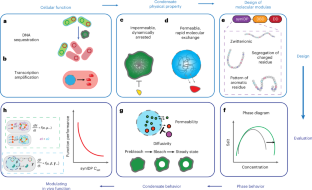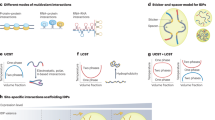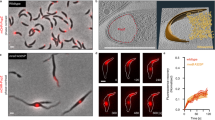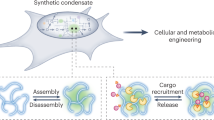Abstract
The formation of biomolecular condensates mediated by a coupling of associative and segregative phase transitions plays a critical role in controlling diverse cellular functions in nature. This has inspired the use of phase transitions to design synthetic systems. While design rules of phase transitions have been established for many synthetic intrinsically disordered proteins, most efforts have focused on investigating their phase behaviors in a test tube. Here, we present a rational engineering approach to program the formation and physical properties of synthetic condensates to achieve intended cellular functions. We demonstrate this approach through targeted plasmid sequestration and transcription regulation in bacteria and modulation of a protein circuit in mammalian cells. Our approach lays the foundation for engineering designer condensates for synthetic biology applications.

This is a preview of subscription content, access via your institution
Access options
Access Nature and 54 other Nature Portfolio journals
Get Nature+, our best-value online-access subscription
$29.99 / 30 days
cancel any time
Subscribe to this journal
Receive 12 print issues and online access
$259.00 per year
only $21.58 per issue
Buy this article
- Purchase on Springer Link
- Instant access to full article PDF
Prices may be subject to local taxes which are calculated during checkout






Similar content being viewed by others
Data availability
All data supporting the findings of this work are provided within the manuscript and its related Supplementary Information. Source data are provided with this paper.
Code availability
The simulation and data analysis code used in this study are deposited at GitHub at https://github.com/youlab/Programmable-Synthetic-Condensates and https://github.com/Pappulab/LASSI.
References
Brangwynne, C. P. et al. Germline P granules are liquid droplets that localize by controlled dissolution/condensation. Science 324, 1729–1732 (2009).
Molliex, A. et al. Phase separation by low complexity domains promotes stress granule assembly and drives pathological fibrillization. Cell 163, 123–133 (2015).
Lyon, A. S., Peeples, W. B. & Rosen, M. K. A framework for understanding the functions of biomolecular condensates across scales. Nat. Rev. Mol. Cell Biol. 22, 215–235 (2021).
Tsang, B., Pritišanac, I., Scherer, S. W., Moses, A. M. & Forman-Kay, J. D. Phase separation as a missing mechanism for interpretation of disease mutations. Cell 183, 1742–1756 (2020).
Roden, C. A. et al. Double-stranded RNA drives SARS-CoV-2 nucleocapsid protein to undergo phase separation at specific temperatures. Nucleic Acids Res. 50, 8168–8192 (2022).
Roden, C. & Gladfelter, A. S. RNA contributions to the form and function of biomolecular condensates. Nat. Rev. Mol. Cell Biol. 22, 183–195 (2021).
Garabedian, M. V. et al. Designer membraneless organelles sequester native factors for control of cell behavior. Nat. Chem. Biol. 17, 998–1007 (2021).
Reinkemeier, C. D., Girona, G. E. & Lemke, E. A. Designer membraneless organelles enable codon reassignment of selected mRNAs in eukaryotes. Science 363, eaaw2644 (2019).
Zhao, E. M. et al. Light-based control of metabolic flux through assembly of synthetic organelles. Nat. Chem. Biol. 15, 589–597 (2019).
Das, R. K. & Pappu, R. V. Conformations of intrinsically disordered proteins are influenced by linear sequence distributions of oppositely charged residues. Proc. Natl Acad. Sci. USA 110, 13392–13397 (2013).
Wei, M. -T. et al. Phase behaviour of disordered proteins underlying low density and high permeability of liquid organelles. Nat. Chem. 9, 1118–1125 (2017).
Wang, J. et al. A molecular grammar governing the driving forces for phase separation of prion-like RNA binding proteins. Cell 174, 688–699 (2018).
Martin, E. W. et al. Valence and patterning of aromatic residues determine the phase behavior of prion-like domains. Science 367, 694–699 (2020).
Bremer, A. et al. Deciphering how naturally occurring sequence features impact the phase behaviours of disordered prion-like domains. Nat. Chem. 14, 196–207 (2022).
Dzuricky, M., Rogers, B. A., Shahid, A., Cremer, P. S. & Chilkoti, A. De novo engineering of intracellular condensates using artificial disordered proteins. Nat. Chem. 12, 814–825 (2020).
Quiroz, F. G. & Chilkoti, A. Sequence heuristics to encode phase behaviour in intrinsically disordered protein polymers. Nat. Mater. 14, 1164–1171 (2015).
Patel, A. et al. A liquid-to-solid phase transition of the ALS protein FUS accelerated by disease mutation. Cell 162, 1066–1077 (2015).
Zhou, H.-X. & Pang, X. Electrostatic interactions in protein structure, folding, binding, and condensation. Chem. Rev. 118, 1691–1741 (2018).
Jalal, A. S. B. et al. Diversification of DNA-binding specificity by permissive and specificity-switching mutations in the ParB/Noc protein family. Cell Rep. 32, 107928 (2020).
Livny, J., Yamaichi, Y. & Waldor, M. K. Distribution of centromere-like parS sites in bacteria: insights from comparative genomics. J. Bacteriol. 189, 8693–8703 (2007).
Schumacher, M. A. & Funnell, B. E. Structures of ParB bound to DNA reveal mechanism of partition complex formation. Nature 438, 516–519 (2005).
Chen, B.-W., Lin, M.-H., Chu, C.-H., Hsu, C.-E. & Sun, Y.-J. Insights into ParB spreading from the complex structure of Spo0J and parS. Proc. Natl Acad. Sci. USA 112, 6613–6618 (2015).
Osorio-Valeriano, M. et al. The CTPase activity of ParB determines the size and dynamics of prokaryotic DNA partition complexes. Mol. Cell 81, 3992–4007 (2021).
Zacharias, D. A., Violin, J. D., Newton, A. C. & Tsien, R. Y. Partitioning of lipid-modified monomeric GFPs into membrane microdomains of live cells. Science 296, 913–916 (2002).
Choi, J.-M., Holehouse, A. S. & Pappu, R. V. Physical principles underlying the complex biology of intracellular phase transitions. Annu. Rev. Biophys. 49, 107–133 (2020).
Allen, R. & David, G. The Zeiss–Nomarski differential interference equipment for transmitted-light microscopy. Z. Wiss. Mikrosk. 69, 193–221 (1969).
Alberti, S., Gladfelter, A. & Mittag, T. Considerations and challenges in studying liquid–liquid phase separation and biomolecular condensates. Cell 176, 419–434 (2019).
Boija, A. et al. Transcription factors activate genes through the phase-separation capacity of their activation domains. Cell 175, 1842–1855 (2018).
Marenduzzo, D., Finan, K. & Cook, P. R. The depletion attraction: an underappreciated force driving cellular organization. J. Cell Biol. 175, 681–686 (2006).
Holehouse, A. S., Ginell, G. M., Griffith, D. & Böke, E. Clustering of aromatic residues in prion-like domains can tune the formation, state, and organization of biomolecular condensates. Biochemistry 60, 3566–3581 (2021).
Lin, Y.-H. & Chan, H. S. Phase separation and single-chain compactness of charged disordered proteins are strongly correlated. Biophys. J. 112, 2043–2046 (2017).
Milkovic, N. M. & Mittag, T. Determination of protein phase diagrams by centrifugation. Methods Mol. Biol. 2141, 685–702 (2020).
Choi, J.-M., Dar, F. & Pappu, R. V. LASSI: a lattice model for simulating phase transitions of multivalent proteins. PLoS Comput. Biol. 15, e1007028 (2019).
Banani, S. F. et al. Compositional control of phase-separated cellular bodies. Cell 166, 651–663 (2016).
Molinari, S. et al. A synthetic system for asymmetric cell division in Escherichia coli. Nat. Chem. Biol. 15, 917–924 (2019).
Lin, D.-W. et al. Construction of intracellular asymmetry and asymmetric division in Escherichia coli. Nat. Commun. 12, 888 (2021).
Cox, R. S., Dunlop, M. J. & Elowitz, M. B. A synthetic three-color scaffold for monitoring genetic regulation and noise. J. Biol. Eng. 4, 10 (2010).
Browning, D. F. & Busby, S. J. W. The regulation of bacterial transcription initiation. Nat. Rev. Microbiol. 2, 57–65 (2004).
Lopatkin, A. J. et al. Antibiotics as a selective driver for conjugation dynamics. Nat. Microbiol. 1, 16044 (2016).
Lopatkin, A. J. et al. Persistence and reversal of plasmid-mediated antibiotic resistance. Nat. Commun. 8, 1689 (2017).
Dong, C., Fontana, J., Patel, A., Carothers, J. M. & Zalatan, J. G. Synthetic CRISPR–Cas gene activators for transcriptional reprogramming in bacteria. Nat. Commun. 9, 2489 (2018).
Gao, X. J., Chong, L. S., Kim, M. S. & Elowitz, M. B. Programmable protein circuits in living cells. Science 361, 1252–1258 (2018).
Kampmeyer, C. et al. Disease-linked mutations cause exposure of a protein quality control degron. Structure 30, 1245–1253 (2022).
Ghosh, I., Hamilton, A. D. & Regan, L. Antiparallel leucine zipper-directed protein reassembly: application to the green fluorescent protein. J. Am. Chem. Soc. 122, 5658–5659 (2000).
Singer-Sam, J. et al. Sequence of the promoter region of the gene for human X-linked 3-phosphoglycerate kinase. Gene 32, 409–417 (1984).
Kleaveland, B., Shi, C. Y., Stefano, J. & Bartel, D. P. A network of noncoding regulatory RNAs acts in the mammalian brain. Cell 174, 350–362 (2018).
Lichtenthaler, F. W. 100 years ‘Schlüssel–Schloss–Prinzip’: what made Emil Fischer use this analogy? Angew. Chem. Int. Ed. Engl. 33, 2364–2374 (1995).
Tang, N. C. & Chilkoti, A. Combinatorial codon scrambling enables scalable gene synthesis and amplification of repetitive proteins. Nat. Mater. 15, 419–424 (2016).
McDaniel, J. R., MacKay, J. A., Quiroz, F. G. & Chilkoti, A. Recursive directional ligation by plasmid reconstruction allows rapid and seamless cloning of oligomeric genes. Biomacromolecules 11, 944–952 (2010).
Block, H. et al. Immobilized-metal affinity chromatography (IMAC): a review. Methods Enzymol. 463, 439–473 (2009).
Alberti, S. et al. A user’s guide for phase separation assays with purified proteins. J. Mol. Biol. 430, 4806–4820 (2018).
Young, J. W. et al. Measuring single-cell gene expression dynamics in bacteria using fluorescence time-lapse microscopy. Nat. Protoc. 7, 80–88 (2012).
Taylor, N. O., Wei, M.-T., Stone, H. A. & Brangwynne, C. P. Quantifying dynamics in phase-separated condensates using fluorescence recovery after photobleaching. Biophys. J. 117, 1285–1300 (2019).
Peran, I., Martin, E. W. & Mittag, T. Walking along a protein phase diagram to determine coexistence points by static light scattering. Methods Mol. Biol. 2141, 715–730 (2020).
Acknowledgements
We thank the Duke Light Microscopy core facility for experimental support. We are grateful to T. Wang at Duke University and C. Roden and A. Gladfelter at UNC Chapel Hill for helpful discussions. J.S. acknowledges the support of the NSF through a graduate research fellowship (DGE-2139754). This work was supported by the Air Force Office of Scientific Research (FA9550-20-1-0241 to L.Y., A.C. and R.V.P.) and by the NIH (MIRA R35GM127042 to A.C. and R01EB031869 to L.Y.).
Author information
Authors and Affiliations
Contributions
Y.D., A.C. and L.Y. conceived the idea. Y.D., X.Z., R.V.P., A.C. and L.Y. designed the experimental and computational studies. M.F. and X.Z. performed LaSSi simulations. Y.D., X.G., H.S., M.N. and D.M.S. cloned the plasmids and prepared the cell lines. Y.D., K.K. and H.-i.S. performed cellular assays for plasmid partition and HGT. Y.D. and X.G. evaluated phase behaviors and condensate behaviors in vitro. Y.D. and D.L. analyzed the cellular assay data and established ordinary differential equation (ODE) models. Y.D. and D.L. conducted the cellular assay for transcription. Y.D., J.M., X.G., J.S. and N.P. performed the mammalian cell experiments. Y.D., R.V.P., A.C. and L.Y. wrote and revised multiple versions of the manuscript. All the authors read and contributed revisions. All the authors analyzed the data and contributed to discussions. A.C., R.V.P. and L.Y. supervised the work and acquired funding.
Corresponding authors
Ethics declarations
Competing interests
The authors declare no competing interests.
Peer review
Peer review information
Nature Chemical Biology thanks the anonymous reviewers for their contribution to the peer review of this work.
Additional information
Publisher’s note Springer Nature remains neutral with regard to jurisdictional claims in published maps and institutional affiliations.
Extended data
Extended Data Fig. 1 Evaluation of the effects of protein domain on condensate formation in cell.
a, Confocal fluorescence images of cells containing dParB DNA binding domain (DBD) (126-254)-mEGFP fusion and dParB DNA binding domain and dimerization domain (DBD-DD) (126-304)-mEGFP fusion. Neither of the constructs were able to show distinct puncta in cell. n = 3 independent biological repeats with similar results. Scale bar is 10 μm. b, Confocal differential interference channel (DIC) images for the evaluations of condensate formation in cells containing constructs expressing RLPWT, RLPWT-DBD, RLPWT-DBD-DD after 1 h of induction. n = 3 independent biological repeats with similar results. c, Estimation of intracellular protein concentrations by purified mEGFP protein. To establish a calibration curve, different concentrations of purified mEGFP protein were titrated into the cellular sample as shown in the top left panel to obtain an accurate calibration at the imaging Z coordinate. Because of the substantial difference between the dense phase and the dilute phase, to prevent oversaturation of fluorescence signal while capable of obtaining accurate fluorescence intensity measurement, the energy of the WLL, the percentage of the intensity of the excitation laser, the detector range and pin hole size were tuned to cover the fluorescence signal of the dense and the dilute phase. If the dense phase signal is oversaturated or the dilute phase signal is similar to the non-fluorescence background sample, then the tuning process would start again until the range is covered. The background fluorescence intensity per pixel was analyzed by LAS X built-in module. The fluorescence intensity corresponding to different concentrations of purified mEGFP was utilized to construct the calibration curve (top right panel), which is utilized to estimate the intracellular protein concentration. The estimated intracellular dilute and dense phase concentration are shown in the bottom panel. Scale bar is 2.5 μm. n = 4 biologically independent samples. Error bar represents standard deviation.
Extended Data Fig. 2 Phase separation assay investigations of resilin-like polypeptide in response to various biochemical conditions.
a, Salt-dependent and concentration-dependent formation of condensate based on different concentrations of RLPWT ([GRGDSPYS]20) (with 10% RLPWT-sfGFP) in 50 mM Tris with different concentrations of NaCl at pH 7.2, confirming its salt-sensitivity and the contribution of electrostatic interaction in condensate formation. Scale bar is 10 μm. n = 3 independent biological repeats with similar results. b, Evaluation of responsive phase behavior using 5 μM of RLPWT ([GRGDSPYS]20) (with 10% RLPWT-sfGFP) in 50 mM Tris and 2 M KCl at pH 7.2. Reentrant condensate formation at high-salt condition using 2 M KCl, indicating the contribution of hydrophobic residues to the condensate formation. Treating the condensate with hydrophobic molecule 1,6-hexanediol, which is known to disrupt non-ionic interactions in condensate, dissolves the condensate. In the meantime, treating the condensate with adenosine triphosphate (ATP), which is known to disrupt electrostatic interaction in the condensate, shows no effect on condensate integrity. The above results confirmed the contributions of non-ionic residues to condensate stability. Overall, the biochemical tests demonstrated that synIDPs can also be modulated by various biochemical cues just as its native orthologs. Scale bar is 10 μm. n = 3 independent biological repeats with similar results.
Extended Data Fig. 3 Characterization of rationally designed synIDPs based on modifications of the WT RLP sequence [GRGDSPYS]20 using sedimentation assay and fluorescent recovery after photobleaching.
a, Designs of synIDPs by repatterning the charge residues20. Charged residues are segregated into individual repetitive motif as shown in the sequences GRGRSPYS/GDGDSPYS. b,c, Sedimentation assay evaluation of the dilute phase concentration(Cdilute) and the dense phase concentration (Cdense) of the designed synIDPs. The segregation of charged residues increases the phase separation propensity with lowered left binodal; in the meantime, no notable change of the dense phase concentration was observed. Above results suggested that enhanced electrostatic interaction by segregation of the oppositely charged residues in a zwitterionic IDP can promote phase separation propensity. d, Designs of synIDPs by varying the uniformity and the quantity of the aromatic residues23,24. For changing the uniformity of the aromatic residues, tyrosine (Y) residues are clustered into a single motif by exchanging with the spacer residue serine (S) as shown in the sequences GRGDSPSS/GRGDYPYS. For reducing the number of aromatic residues, 50% of tyrosine is substituted by valine (V). e,f, Evaluation of the dilute phase concentration (Cdilute) and the dense phase concentration (Cdense) of the designed IDPs by sedimentation assay. Cluster of aromatic residues enhances both phase separation propensity and the dense phase concentration. Decreasing the number of tyrosine residues decreases both phase separation propensity and the dense phase concentration. Above results demonstrated that pi-based interactions can modulate both phase separation propensity and dense phase property. n = 3 different experiments. Mean ± SD.
Extended Data Fig. 4 FRAP and computational analysis of condensates formed by synIDPs.
a–e, Proteins was prepared at 50 µM (in buffer containing 50 mM Tris, 125 mM NaCl, pH 7.2) to ensure all the samples have visible condensates. a, FRAP images and recovery curves of condensates formed by different types of synIDPs (doped with 10% of sfGFP labeled IDPs). Scale bar is 5 μm. b, Comparison of derived apparent diffusion coefficients of condensates formed by different artificial IDPs based on recovery curve fitted by single exponential fitting equation and the corresponding bleaching area. c, Mean square displacement (MSD) values of chains in WT (black) or S-Y (blue) condensates. MSD values are in square lattice units per 2.5 × 107 total system Monte Carlo moves. Standard errors from the mean across five independent simulations are smaller than the marker sizes. d, Evaluation of the likelihood for a chain to exit the condensates after 5 × 109 Monte Carlo moves by comparing the amounts of chain still in the condensates with the amounts of chain moving out of the condensates. e, Comparison of derived apparent diffusion coefficients of condensates formed by different protein components. n = 3 independent experiments. Bar graph represents mean ± SD. *, p < 0.025; **, p < 0.006 by a two-tailed unpaired t-test.
Extended Data Fig. 5 Evaluation of heterotypic driving force on the formation of DNA condensate and the partition of RNAP into the DNA condensate.
a, DNA condensate constituted by 500 nM of RLPWT-DBD-DD (doped with 10% RLPWT-DBD-DD -sfGFP) and 25 nM cy3-DNA containing one or two parS sites. Scale bar is 10 μm. b, Mixture of 500 nM of RLPWT-DBD (doped with 10% RLPWT-DBD-sfGFP) and 25 nM cy3-DNA containing no parS site did not result the formation of condensate. Scale bar is 10 μm. c, Fluorescence based sedimentation assay measurements of the dilute/dense phase concentrations of RLPWT-DBD (doped with 10% RLPWT-DBD-sfGFP) in the presence of 25 nM DNA with different number of parS binding sites. For measuring the dilute phase, the fluorescence was directly quantified from the supernatant after sedimentation (Methods). For measuring the dense phase, 1 µL of the dense phase was extracted and dissolved into 49 µL buffer before taking the measurements. n = 6 independent experiments. *, p = 0.0134; **, p = 0.0012; **, p = 0.0015 by a two-tailed unpaired t-test. Error bar represents standard deviation. d, Normalized fluorescence recovery curve of DNA channel based on the DNA condensate formed by different components. For evaluation of the mobility of cy3-DNA, the protein component was not doped with sfGFP labeled protein. e, Normalized fluorescence recovery curve of Dextran (150 KDa) channel based on the DNA condensate formed in Fig. 3g. n = 3 independent experiments. Data point represents mean ± SD. f, Evaluation of partition coefficient of Alexa488-labeled T7 RNAP into different DNA condensates containing 1 µM of RLP-dParB and 25 nM of DNA containing one parS site. n = 5 independent experiments. Bar graph represents mean ± SD. ****, p < 0.0001; ***, p < 0.0005 by a two-tailed unpaired t-test.
Extended Data Fig. 6 Evaluation of condensate mediated plasmid partition.
a, Experimental procedure to measure plasmid loss. b,c, Evaluation of change of total cell counts based on different testing conditions under the selection of kanamycin or kanamycin and chloramphenicol after 5 h of growth with/without induction. n = 4 biologically independent samples. Bar graph represents mean ± SD. d, Comparison of change of fraction of cells carrying both plasmids based on the location of the parS site after 5 h of induction with 0.5 mM IPTG. n = 3 biologically independent samples. Bar graph represents mean ± SD. e, Evaluation of the contribution of dimerization domain on modulating the fraction of cells carrying two plasmids after 90 min of induction with 0.5 mM IPTG. n = 3 biologically independent samples. **, p = 0.0079 by a two-tailed unpaired t-test. Bar graph represents mean ± SD.
Extended Data Fig. 7 Modulation of cellular functions using synIDPs with different phase behaviors.
a, Computational simulation demonstrates the influences of the critical concentration of phase separation on plasmid partition efficiency. Enhancing plasmid partition follows the trend of decreasing critical concentration for phase separation. b, Effects of different synIDP-DBD-DD constructs on asymmetric plasmid partition at different time points after induction with IPTG induction level at 0.1 mM IPTG and 0.2 % arabinose by evaluating the fraction of progenitor cells (the amount of cells carries both plasmids). n = 3 biologically independent samples. Bar graph represents mean ± SD. c, Experimental data fitted ODE models of different synIDP-DBD-DD constructs on asymmetric plasmid partition at different time points after induction with IPTG induction level at 0.1 mM IPTG and 0.2 % arabinose. n = 3 biologically independent samples. d, Correlation between experimental evaluated biochemical property of IDP (concentration at dilute phase) and simulated β value (an artificial value indicating the effects of phase separation on asymmetric plasmid partition). Black line is the linear fit of the data with an R-square value of 0.846.
Extended Data Fig. 8 Evaluation of phase separation on modulating protein activity in mammalian cells.
a, Evaluation of cell viability with or without the transfection of plasmid containing RLPS-Y-Nzipper after 48 h of transfection. n = 3 biologically independent samples. Bar graph represents mean ± SD. b, Time-dependent formation of synthetic condensates and recruitment of reporter protein. c, FRAP analysis of RLPS-Y-mCherry-Nzipper and Czipper-Citrine-DHFR within condensates in HEK293 cells. n = 3 independent experiments. Data point represents mean ± SD. d, Dose-dependent modulation of protein activity. Cells was transfected with different amounts of plasmid containing RLPS-Y-mCherry-Nzipper and 0.5 µg of plasmid containing Czipper-Citrine-DHFR. Right panel shows representative confocal images after 48 h of transfection.
Supplementary information
Supplementary Information
Supplementary Figs. 1–3, Tables 1–3, Notes and References.
Source data
Source Data Fig. 2
Evaluations of the molecular dynamics and permeability of synthetic DNA condensates.
Source Data Fig. 3
DNA sequestration performance based on percentage and fractions of cellular populations.
Source Data Fig. 4
Transcription amplification data based on fluorescence quantification.
Source Data Fig. 5
Protein activity quantification based on fluorescence quantification.
Source Data Fig. 6
Estimation of intracellular protein concentration using calibration curve.
Source Data Extended Data Fig. 1
Evaluation of the phase diagram using a sedimentation assay.
Source Data Extended Data Fig. 3
Component diffusion kinetics analysis.
Source Data Extended Data Fig. 4
Effects of heterotypic driving forces on phase diagram.
Source Data Extended Data Fig. 5
Plasmid partition fraction based on different components.
Source Data Extended Data Fig. 6
Computational simulation data on plasmid sequestration.
Source Data Extended Data Fig. 7
Cell viability data and quantification of fluorescence signals of synthetic condensates in mammalian cells.
Source Data Extended Data Fig. 8
Cell viability data and quantification of fluorescence signals of synthetic condensates in mammalian cells.
Rights and permissions
Springer Nature or its licensor (e.g. a society or other partner) holds exclusive rights to this article under a publishing agreement with the author(s) or other rightsholder(s); author self-archiving of the accepted manuscript version of this article is solely governed by the terms of such publishing agreement and applicable law.
About this article
Cite this article
Dai, Y., Farag, M., Lee, D. et al. Programmable synthetic biomolecular condensates for cellular control. Nat Chem Biol 19, 518–528 (2023). https://doi.org/10.1038/s41589-022-01252-8
Received:
Accepted:
Published:
Issue Date:
DOI: https://doi.org/10.1038/s41589-022-01252-8
This article is cited by
-
Targeting and engineering long non-coding RNAs for cancer therapy
Nature Reviews Genetics (2024)
-
Expanding the molecular language of protein liquid–liquid phase separation
Nature Chemistry (2024)
-
Phase transition of GvpU regulates gas vesicle clustering in bacteria
Nature Microbiology (2024)
-
Sequestration within peptide coacervates improves the fluorescence intensity, kinetics, and limits of detection of dye-based DNA biosensors
Communications Chemistry (2024)
-
How phase separation is revolutionizing biology
Nature (2024)



